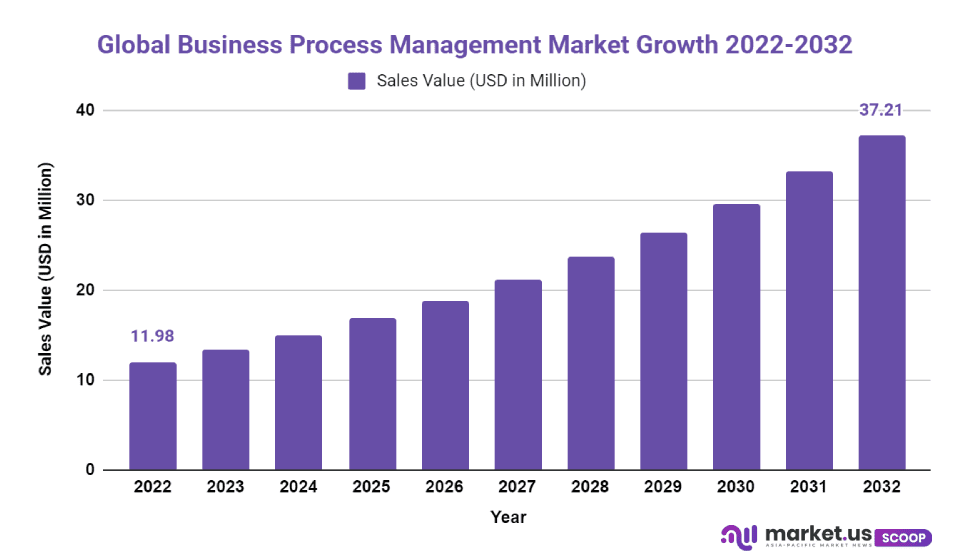Organizations Embracing Digital Revolution for Increased Efficiency, Rapidly Adapting to Business Process Management, says Market.us
At Market.us Scoop, we strive to bring you the most accurate and up-to-date information by utilizing a variety of resources, including paid and free sources, primary research, and phone interviews. Our data is available to the public free of charge, and we encourage you to use it to inform your personal or business decisions. If you choose to republish our data on your own website, we simply ask that you provide a proper citation or link back to the respective page on Market.us Scoop. We appreciate your support and look forward to continuing to provide valuable insights for our audience.
Business process management is a discipline that focuses on the design, improvement, and management of business processes. It aims to align an organization’s activities and resources with its business goals and objectives in order to improve efficiency, effectiveness, and agility.
The increasing adoption of digital technologies, such as cloud computing, artificial intelligence, and the Internet of Things, is driving the need for organizations to optimize and automate their business processes. The goal of business process management is to ensure that an organization’s processes are aligned with its strategic goals, that they are efficient and effective, and that they can adapt to changing business needs and circumstances.
According to a report by Market.us, “ The Global Business process management market size was valued at USD 11.98 billion in 2022 and is forecast to a readjusted size of USD 27.58 billion by 2032 with a CAGR of 12% during the review period.”

Anurag Sharma, the senior research analyst at Market.us, said, “Businesses face increasing pressure to reduce costs and increase efficiency; they are looking for ways to streamline and optimize business processes. BPM can help organizations identify and eliminate waste, reduce errors, and increase productivity, resulting in cost savings.
BPM solutions can help organizations design and implement digital processes that are more efficient, agile, and scalable. Customers who become more digitally savvy expect faster and more personalized service from the organizations they interact with.
BPM solutions can help organizations design and implement more customer-centric processes and be responsive to changing customer needs. The increasing complexity of regulatory environments is driving the need for organizations to have more transparent and traceable business processes.
BPM solutions can help organizations design and implement processes that are compliant with various regulations, such as data protection laws and environmental regulations. As businesses increasingly operate on a global scale, they face the challenge of managing processes across different countries, cultures, and time zones. BPM solutions can help organizations design and implement flexible and adaptable processes in diverse operating environments.
Artificial intelligence (AI) and machine learning (ML) are becoming increasingly common in BPM, as these technologies can help to automate and optimize processes. For example, AI and ML can identify patterns and trends in process data, predict outcomes, and recommend process improvements.
The use of cloud-based BPM solutions is growing as they offer several benefits, such as lower upfront costs, faster deployment, and easier scalability. Cloud-based BPM solutions also allow for more flexible and remote collaboration, which is important in the current pandemic-induced remote work environment.
Process mining is a technique that uses data from an organization’s systems to create a visual representation of its business processes automatically. Process mining can help organizations to understand how their processes are being executed, identify bottlenecks and inefficiencies, and optimize their processes.
Low-code/no-code BPM platforms allow users to design and implement processes without needing to write any code. This makes it easier for organizations to design and deploy new processes quickly and allows for more flexible and iterative process design. Robotic process automation (RPA) uses software robots to automate repetitive and rules-based tasks. RPA can be integrated with BPM solutions to automate further and optimize processes.
Implementing BPM can be costly, particularly for small and medium-sized enterprises. The upfront costs of purchasing and implementing BPM software and hardware, as well as the ongoing costs of training and maintenance, can be a barrier for some organizations. It can involve a complex and time-consuming process of redesigning and implementing new business processes. This can challenge organizations with limited resources or expertise in BPM.
Change can be difficult, and employees may resist implementing new business processes, particularly if they feel that their roles or responsibilities are being threatened. Managing change and addressing employee concerns is an important aspect of successful BPM implementations.
BPM may require integration with an organization’s existing systems and processes, which can be challenging if outdated or inflexible. It often involves collecting and analyzing large amounts of data, which can raise concerns about data security and privacy. Organizations implementing BPM solutions must ensure that they have robust data protection measures.
Ketan Mahajan
Hey! I am Ketan, working as a DME/SEO having 5+ Years of experience in this field leads to building new strategies and creating better results. I am always ready to contribute knowledge and that sounds more interesting when it comes to positive/negative outcomes.
Latest from Author
- Electric Vehicles Technology Advances in the Future
- The App Revenue Industry Has Witnessed Remarkable Revenue Growth
- AI in Healthcare Statistics: Pioneering Tech With Health
- The Versatility of Structural Core Material Market is Strengthening the Demand, says Market.us
- The Potential of the Digital Twin Market Rises Due to Improved Efficiency, says Market.us